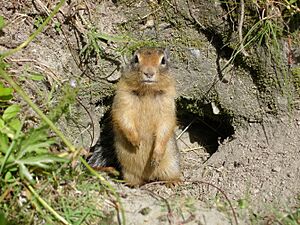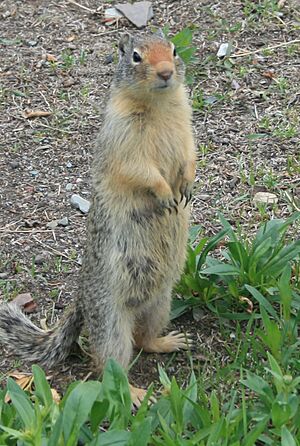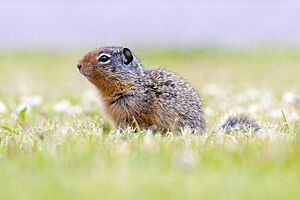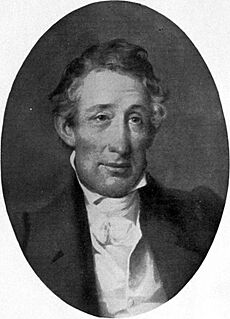Columbian ground squirrel facts for kids
Quick facts for kids Columbian ground squirrel |
|
|---|---|
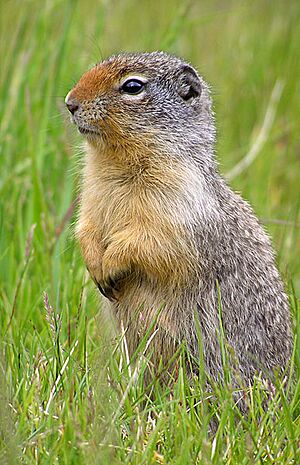 |
|
| in Alberta, Canada | |
| Conservation status | |
| Scientific classification | |
| Genus: |
Urocitellus
|
| Species: |
columbianus
|
 |
|
| Distribution of the Columbian ground squirrel | |
| Synonyms | |
|
List
Arctomys columbianus
Ord, 1815 Spermophilus columbianus Merriam and Stejneger, 1891 S. c. albertae Allen, 1903 Anisonyx brachiura Rafinesque, 1817 |
|
The Columbian ground squirrel (Urocitellus columbianus) is a type of rodent found in parts of Canada and the northwestern United States. It's like a large chipmunk or a small marmot. These squirrels are sturdy with short, thick fur. They have a reddish-brown color on their nose.
When they meet, they sometimes touch noses, which looks like a "kiss." The most common thing they do above ground is stand tall and look around. They live in mountains and high plains. They sleep for 8 to 9 months each year in their burrows. These burrows can be used for many years. When they wake up in the spring, they are very thin. Scientists first learned about these squirrels from the journals of Lewis and Clark.
Contents
What Does a Columbian Ground Squirrel Look Like?
The Columbian ground squirrel is one of the biggest ground squirrels. Only the Arctic ground squirrel is larger. They have a strong, solid body. They are about 325–410 mm (12.8–16.1 in) long, including their tail. Their tail is about 80–116 mm (3.1–4.6 in) long.
Their fur is thick and short. The fur on their face is bronze, especially on their nose. The fur on their back, legs, and feet is a cinnamon-brown color. It gets darker closer to their body. They have a light beige ring of fur around their eyes. The fur on their neck and cheeks is gray. Their sides can be light beige or gray. Their tail is darker, with some lighter beige marks on top.
There are two types, or subspecies, of Columbian ground squirrels. They look a bit different. One type, called U. c. ruficaudus, has a tail that is more reddish and less gray. Its face and throat are also a deeper rust color. Its legs and feet are darker too.
Sometimes, squirrels are born with albino features. This means they have white hair and pink eyes. Scientists have found a few albino Columbian ground squirrels. This suggests that the gene for albinism stays in their local populations.
Where Do They Live?
Columbian ground squirrels live in western North America. You can find them in the Rocky Mountains. Their range goes from western Alberta and southeastern British Columbia in Canada. In the United States, they are found in western Montana, central Idaho, and northern and eastern Washington. They also live on the plains of eastern Washington. In Oregon, they are in the mountains in the east-central part of the state. They live at elevations between 700–8,000 feet (210–2,440 m).
Fossils of Columbian ground squirrels have been found in Idaho. These fossils are from the late Pleistocene era. This shows that these squirrels have lived in these areas for a very long time.
How Do They Behave?
Columbian ground squirrels in Alberta sleep for about 250 days a year. This means they are only active for 69–94 days! How long they are active depends on the weather and the squirrel's age and sex. They start sleeping when the soil in their burrow is warmest. During this sleep, called hibernation, they curl up tightly. Their body temperature drops, and their heart rate and breathing slow down a lot.
Adult males are the first to wake up in the spring. Then come adult females, followed by younger squirrels. Squirrels living in higher, colder places wake up later.
They have one litter of babies each year. The babies are born naked, blind, and without teeth. Their weight doubles in about 5–6 days. By day 12, they have dark, soft hair. Their eyes start to open around day 17. They might come out of the den into the sunlight around 21-24 days old. After 4 weeks, they can leave the nest completely.
Young squirrels only have a few weeks to drink their mother's milk before their first hibernation. The mother's milk changes over time. For example, the amount of calcium in the milk can increase by 134% during the first 17 days after birth. This helps the young get enough nutrition to survive their long sleep.
Squirrels dig burrows with a main entrance and often two hidden escape tunnels. The main tunnels are about 3.5 in (89 mm) wide. Inside, they build nests from grass. They also have special chambers that act like a toilet! Each year, they dig out about 4–12 kg (8.8–26.5 lb) of soil to keep their burrows in good shape. When they build a new burrow, they can move 25–50 kg (55–110 lb) of soil!
When above ground, Columbian ground squirrels spend most of their time standing tall, looking around. They also spend time eating and cleaning themselves. Older males are often more aggressive, especially early in the season. These squirrels don't like cloudy days, cold winds, or bad weather. They come out of their dens about an hour before sunrise and go back in near sunset. They are active during the hottest parts of the day, but you might see them most in the mid-morning.
When two Columbian ground squirrels meet, they often touch their mouths and noses together. This "kissing" lasts a few seconds and often happens before other social interactions.
People who observed these squirrels long ago called them "Seven sleepers." This was because they stayed underground for about seven months of the year. They were very fat when they went into their burrows for hibernation. But they were thin and weak when they came out in the spring.
What About Their Environment and Other Animals?
Columbian ground squirrels live in groups that are spread out in their habitat. They prefer meadows and grasslands in high mountain areas. They can also live in areas where trees have been cut down.
They eat mostly plants. Early in the season, they eat fresh, juicy plants. As plants get tougher, they start eating more grains and seeds. By the end of the season, they are very fat. Scientists found that almost all the squirrels they studied had only plant matter in their stomachs. A small number had traces of insects or other small mammals.
Columbian ground squirrels can get parasites. These include ticks, fleas, and mites. They can also carry bacteria that cause diseases, like the one that causes black plague.
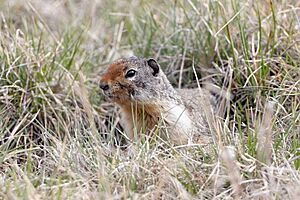
Many animals hunt Columbian ground squirrels. These predators include:
- Grizzly bears
- Coyotes
- Pacific martens
- Grey wolfs
- American badgers
- Weasels
- Mountain lions
Birds of prey also hunt them, such as:
How Are They Classified?
In 1891, a scientist named C. Hart Merriam studied mammals in Idaho. He realized that the "Burrowing Squirrel" described by Lewis and Clark was actually the Columbian ground squirrel. People had thought it was a prairie dog. Merriam showed it was a different species. He named it Spermophilus columbianus.
There are two main types (subspecies) of Columbian ground squirrels:
- Spermophilus columbianus columbianus: This was the first type described in 1815.
- Spermophilus columbianus ruficaudus: This type was described in 1928.
They are also sometimes called burrowing squirrels.
Here's how Columbian ground squirrels fit into their family tree with other ground squirrels: {{clade| style=font-size:85%; line-height:85% |1=
|
||||||||||||||||||||||||||||||||||||||||||||||||||||||||||||||||||||||||||||||||||||||||||||||||||||||||||||||||||||||||||||||||||||||||||||||||||||||||||||||||||||||||||||||||||||||||||||||||||||||||||||||||||||||||||||||||||||||||||||||||||||||||||
|
||||||||||||||||||||||||||||||||||||||||||||||||||||||||||||||||||||||||||||||||||||||||||||||||||||||||||||||||||||||||||||||||||||||||||||||||||||||||||||||||||||||||||||||||||||||||||||||||||||||||||||||||||||||||||||||||||||||||||||||||||||||||||
Columbian Ground Squirrels and People
When farming became common in areas where these squirrels live, they were sometimes seen as pests. This was because they could damage crops like wheat. In 1910, a research station in Washington started a special study. They built fenced areas with squirrel dens to watch them closely. This helped scientists learn more about their habits.
Are Columbian Ground Squirrels Endangered?
The IUCN (International Union for Conservation of Nature) says the Columbian ground squirrel is a species of "least concern." This means they are not in danger of disappearing. They are common and found in many places. There are no big threats to their survival, and their numbers seem to be stable. The state of Montana also sees them as an important part of their ecosystem. They are plentiful and not vulnerable in most of their range.



